Science. Superheroes. Supervillains. But not superpowers. Other people have already done that.
Don't wanna be here? Send us removal request.
Text
Close only counts in horseshoes and hand grenades
Back in JIM (That’s Journey Into Mystery) #102, Thor reveals if he spins around with his hammer at twice the speed of light, he can travel though time.
In JIM #110 we learn he can also ‘stop’ time.
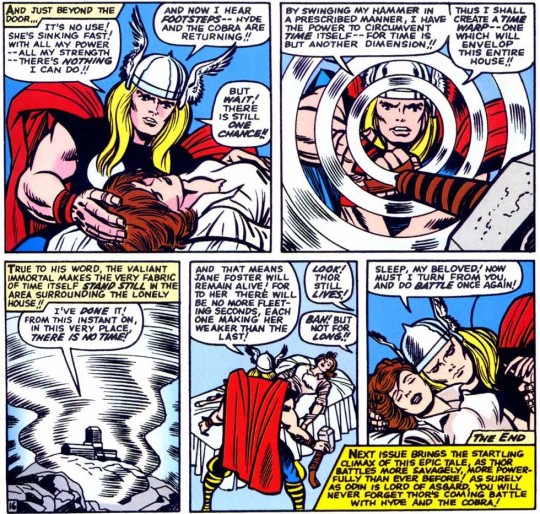
This is so close to vaguely real science. Specifically the rules of Special Relativity, which states that objects traveling at faster speeds have slower internal clocks.* It would only be the hammer that would experiencing the effects, since it’s the only thing that’s moving, but from everyone else’s (including Thor’s) perspective the hammer wouldn’t ‘age’ (Granted, I don’t think the hammer ages in any frame of reference...until Thor stops whirling it around.
The problem, of course, is that from the hammer’s perspective, time is passing normally. Instead, everything around it traveling at a slower speed is aging more rapidly. This is why it’s called “Relativity”.
Also, if time truly stopped, Thor wouldn’t be able to speak or do any actions whatsoever. Movement of any kind wouldn’t be allowed, because that requires some amount of speed (and speed = distance divided by TIME). Oops.
This is a two-parter story, wherein Loki gives two of Thor’s prior baddies power boosts and tells them to kidnap Jane. Then they hide her in a boobytrapped house for Thor to find.
One of those boobytraps involves combustible tear gas. I didn’t know tear gas was combustible. (There are a variety of compounds commonly used for tear gas, none of which are actually gases. They’re aerosols - teeny drops of liquid or flecks of solid somethings suspended in air after leaving their container.) One of the most popular compounds, 2-chlorobenzalmalononitrile (aka CS gas**), has a flammability hazard rating of “1”, which means it has to be heated to some temperature over 93 degrees C (200 F) before it can ignite. But the NIOSH does classify it as combustible.
Fun fact: Mace is like Kleenex. It’s a brand name, but people use it as a generic term. It was invented in 1965, less than a year after this comic was published.
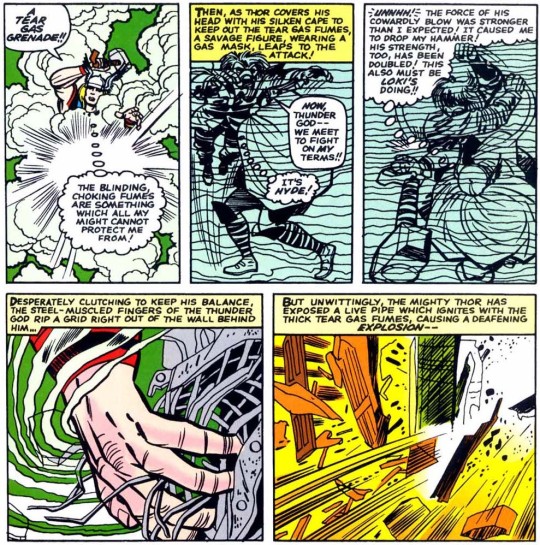
In the second part (issue #111), through shows off his Double E**** skills:
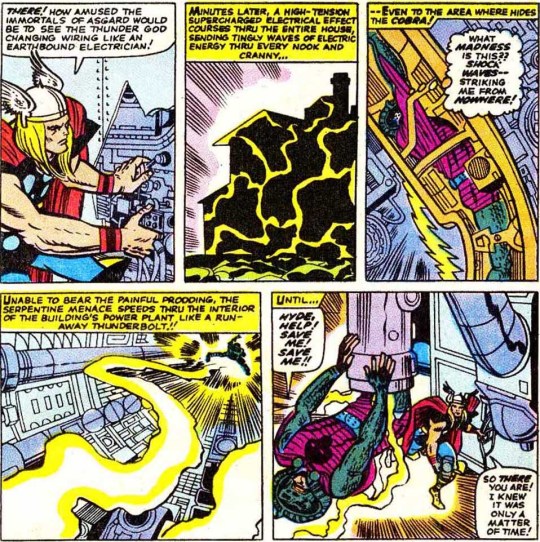
And Balder (sent by Odin to collect a panacea of some sort from a hermit to save Jane’s life) get this close to figuring out what antimatter is.
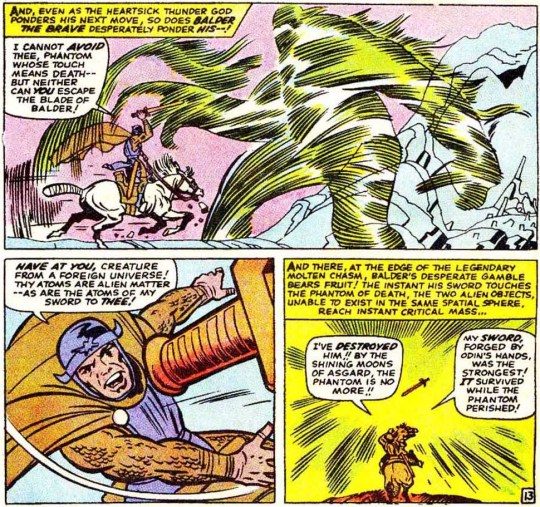
“The instant his sword touches the phantom of death”, which is made of “alien matter”, “the two alien objects, unable to exist in the same spatial sphere, reach instant critical mass”. (The sword survives ‘cause it’s stronger...)
If the alien were truly antimatter, the sword’s matter particles would be annihilated along with the equivalent antimatter particles in the phantom. Neither would survive.
Also, you don’t need critical mass in a matter/antimatter reaction. Well, I guess you do, in that you need the mass equivalent to at minimum one matter particle and its antimatter particle, which is twice the mass of the matter particle. But it’s not the same as the phrase “critical mass” in nuclear chemistry, which is the minimum amount of fissile material needed to sustain a chain reaction. Matter/antimatter reactions produce only light, and therefore can’t induce further reactions like nuclear fission does (releasing free neutrons that can collide into nearby atoms and make them undergo fission, and so on).
* One of two legit ways of time travel. The other uses General Relativity and requires hanging out close to a very massive object.
** Also not a gas. The compound is a solid at room temperature.
*** the lowest temperature at which it can ignite as long as there’s an ignition source. Technically it’s only the molecules that have been vaporized (i.e. turned into a vapor) for which the flash point applies.
**** Which is what we called Electrical Engineering at Caltech (spelled EE...which now in my PhD dissertation refers to Entertainment-Education)
3 notes
·
View notes
Text
M4A
One argument you’ll never hear from the Medicare for All proponents is that, if America adopted it, Spider-Man could spend a lot less time worrying about making money to keep Aunt May from dying instead of, you know, Spider-Manning.

At one point in this issue (#18) he tries to sell his synthetic webbing to a collection of boffins, demo-ing how strong a single strand is, here:
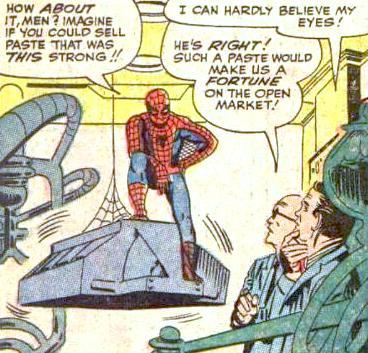
They turn him down because the webbing is designed to dissolve over time (Though apparently in this comic it lasts about a minute, which seems much too short if you need it to tie up some baddies and leave them for the cops to find).
In the previous panel to the one above, the eggheads say that hunk of metal is cast iron.
Let’s compare Spidey’s webbing against actual spider silk.

The density of cast iron (since it’s technically an alloy with a tiny bit of carbon) is less than pure iron, but there’s no one set number. I’ll use a flat 7000 kg per cubic meter to be generous to the webbing. The volume of that block looks to be about 1.75 cubic meters, maybe? That makes the total mass of it a bit over 12 metric tons.
The amount of force webbing can support depends on the cross-section of the strand. A thicker strand can support a heavier object (I mean, that’s true in general for most things). So larger spiders will normally have thicker webbing, but really each species’ webbing is going to have its own properties depending on what the spider uses its webbing for (and any one spider excretes different types of webbing for different jobs, too). This study found a max tensile strength of 1500 MegaPascals (i.e. Newtons of force per square meter the force is distributed over) for Nephila maculata. This one was only 900 MegaPascals for the genus Loxosceles. The range runs from about 450 to 2000 MPa.
So, to lift 12 metric tons (~120,000 Newtons), real spider silk would need to have a thickness of at least 9 mm (nearly a third of a foot!)
Peter’s stuff is definitely thinner than that -- much closer to what we’re hoping to get out of carbon nanotubes. CNTs have a hypothetical max of 70,000 MPa, which could lift that cast iron with a 2 mm-thick strand. Unfortunately we’re still trying to figure out how to grow them longer than the few centimeters...
Apparently Peter’s figured it out, and those bozos are too blind to see the innovation in front of their faces. But I guess it’s for the best. Gotta keep Pete starving ‘cause there’s no other source of stress in his life, am I right?
Photo Credit:
Nephila maculata by Dinesh Valke
4 notes
·
View notes
Text
Reed Richards is a dick.

He’s also a shit scientist.
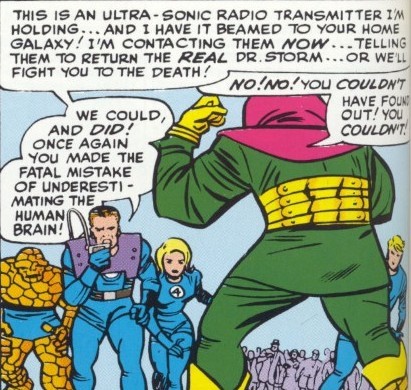
Radio waves are light, not sound, and therefore cannot be “sonic” whether ultra or infra. Radio waves also, being light waves, travel a maximum of c - 300,000 km/s (186,000 miles per second) - which means they take 2.5 million years to travel to Andromeda, home of the Skrulls (and the disguised Super Skrull whose backside is featured here).
One of these days I’m going to ignore the instant communications/travel times for this interplanetary/intergalactic nonsense, but today is not that day.
Probably because Reed Richards is a dick.
At the very least, there is a hint of real science in this issue. Reed mentions an “electron photograph”, which is vaguely reminiscent to electron microscopes, which bounce electrons off tiny things instead of photons because their wavelengths are smaller and can therefore provide more detail of those tiny things.
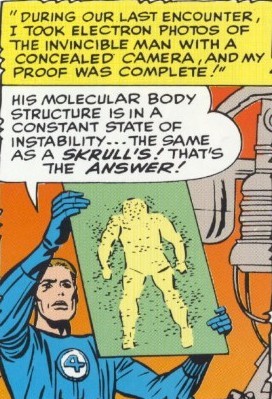
Here’s one of pollen:

Finally, something far more weird than wrong:
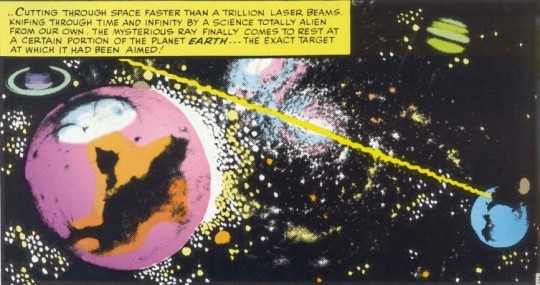
A trillion laser beams travel the exact same speed as a single laser beam through the vacuum of space.
______________________________________________________________________
Oh, and this issue (Fantastic 4 #32) has a hilarious false-advertising cover:
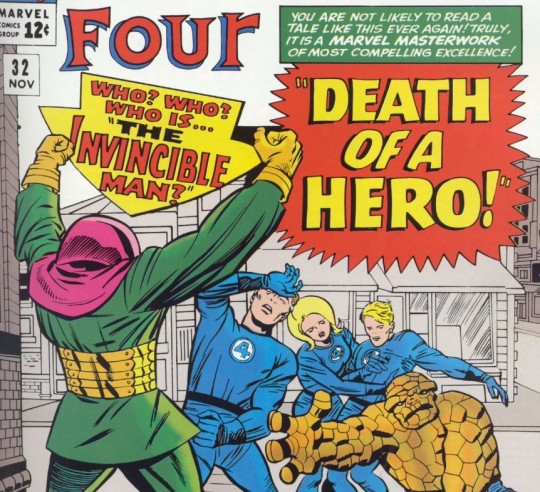
The “hero” that dies? Sue and Johnny’s dad, who’s only called a hero because he rolls onto a space grenade (not actually a grenade) after the Skrulls beam him back to Earth in an attempt to murder the F4.
1 note
·
View note
Text
I’d like to shoutout Strange Tales #126 for acknowledging the consequences of Impulse (the physics property, not the DC speedster), albeit not really.
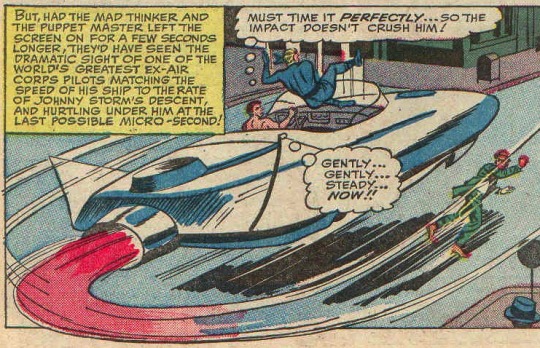
Our radioactive clay-handling friend the Puppet Master is at it again, this time in cahoots with the Thinker...if only reluctantly. The latter swears he has a foolproof plan to defeat the F4, first by having the PM mind control the Thing into punching Johnny Storm’s chest cavity in.
Said plan turns out to not be foolproof, as the Thing shapeshifts back into his human Ben form, gets back in control, and saves the unconscious youth from falling to his doom.
And he saves him not just by catching him right before he hits the ground, but by---and I quote the yellow box in the panel above---“matching the speed of his ship to the rate of Johnny Storm’s descent”. Granted, that line is immediately followed by “hurtling under him at the last possible micro-second”, which means he’s not actually slowing him down over a longer period of time in order to lessen the force Johnny feels during his impact.
That’s where impulse comes in. It’s equal to the change in an object’s momentum (mass times change in velocity), as well as force times timespan. If we assume Johnny had been falling near terminal velocity (which I’m doing given the height he started falling from) We’re talking an impulse of about 4000 kg*m/s. If the Thing slows him down over a microsecond (that’s one millionth of a second!), the force the Torch experiences is 4 billion newtons.
When dealing with unfamiliar units, having a “billion” number doesn’t necessarily mean it’s actually bug. But in this case it is. For comparison, the Saturn V rocket used to send astronauts to the Moon expelled ~35 million newtons of force.
If you ever find yourself piloting some kind of rocket-powered hover car and need to catch a falling someone, you should match their speed when you catch them, but allow yourself several seconds with which to slow your (and their) speed.
I’m dropping some real life lessons, here.
_______________________________________________________________________
Oh, and before I go, I just want to point out that it’s in this issue we learn than PM’s clay isn’t just radioactive. It’s fissionable.
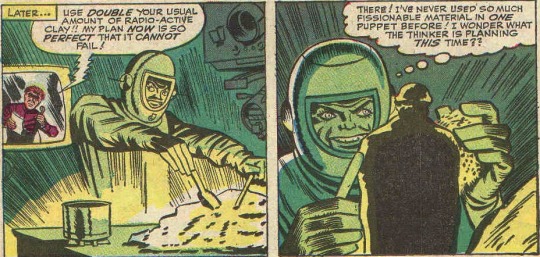
Not all radioactive elements are fissionable. For example, the most abundant form of uranium (U-238) cannot undergo the rapid cleaving into two daughter elements plus some extra neutrons that its sister isotope---the much rarer U-235---can. U-238 just spits out the occasional tiny alpha particle to turn into Thorium.
Why our Puppet Master needs fissionable material when he’s not planning on making a nuclear reactor or a bomb is beyond me. I mean, detonating a nuke would definitely be an easier way of dispatching his enemies than making the technobabble version of a voodoo doll...
0 notes
Text
It’s been a while, true believers. There comes a time when you hit your maximum number of plates you can juggle and you gotta set some aside. But I’m still here. Still alive.
And so is Captain America, who after coming back to ‘life’ in the Avengers #4 (1963) gets his own comic series inside the anthology Tales of Suspense (#59, 1964). Yes, he does have to share with Iron Man, for the time being.

The ‘episode’ isn’t particularly grand. The Avengers (minus Cap) leave town for some shindig and Steve is left at Stark’s mansion in case some emergency breaks out. Some mobsters think it’s a good idea to break in and steal a bunch of tech secrets because the Avengers left their weakest member behind.*
Naturally, they learn their lesson, but there’s a quick moment that’s worthy of at least *some* science commentary.
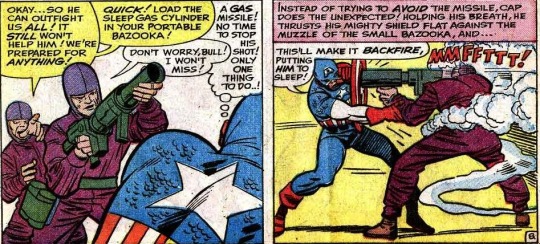
Knockout gas, knockout darts, knockout whathaveyous are more than abundant in fictional media. I’ve seen them before in these very comics -- pretty sure Sue Storm’s been knocked out by more than one gas canister in the past few years.
Exactly what’s in them is never specified. There are loads of inhalation-based sedatives (frequently used as anesthesia in medical procedures**) going back a thousand years. For example, the "soporific sponge" was introduced to Europe from the Arab world in the 12th century. You soaked it in a solution of - among other things - opium, dried it out until you needed it, then wet it a bit and stuck it over your patients face.
Yes, doctors basically did the ‘does this smell like chloroform to you’ bit, except consensually. (Also, chloroform wasn’t discovered until the 1830s...These days, they use it to make Teflon.) But for those of you wondering how long it takes a person to get knocked out from such a method, we’re talking about several minutes. Holding a rag against someone’s face or, say, launching a canister into a room, doesn’t instantly knock a person out.
The only way to knock someone out in a few seconds is to cut off their access to oxygen entirely. Even in the vacuum of space you’ll stay conscious for about 10 seconds, whether you’re a super soldier or a mafia peon.
You can’t even (safely) knock someone out by hitting them in the head. Another trope featured in most action pop culture content. But that’s another complaint for another week.
* Up until this point, Hawkeye has only appeared one time and was an Iron Man villain.
** They gave me nitrous oxide (aka “laughing gas”) when they took my wisdom teeth out many moons ago for what’s referred to as “twilight anesthesia”. I never laughed, but distinctly remember becoming conscious enough to hear talking and feel fingers and tools inside my mouth (but no pain) at one point during the surgery.
Tales of Suspense #59 - Writer: Stan Lee, Art: Jack Kirby, Ink: Chic Stone
0 notes
Text
NaNoWriMo
I’ve never participated in this event (National Novel Writing Month), and I guess I’m still not due to a technicality.
Instead of a novel, I’m going to work on my second screenplay. The goal is to try and adapt this novel I never finished writing but started last decade, but managed to write up a good 100 pages or so. I went back and read it a while ago and it’s not actually that good in terms of plot or character arc (I like the characters, though). So, this month I want to rework it from the bones and just get a first draft completed, whatever the quality.
I’ll update this post with, instead of the number of words, the number of pages. A typical feature screenplay is between 90 and 120 pages long, with each page corresponding roughly to 1 minute of screentime.
Nov 0: 23.5 pgs
Nov 1: 8.5 pgs
Nov 2: 11 pgs
Nov 3: 5 pgs
Nov 4: 7 pgs
Nov 5: 6 pgs
Nov 6: 7.5 pgs
Nov 7: 5 pgs
Nov 8: 8.5 pgs
Nov 9: 11 pgs
Nov 10: 7 pgs
Nov 11: 3 pgs
Nov 12: 4 pgs
Nov 13: 6.5 pgs (114.5 total) completion of Draft 0!
Nov 14: 14.5 pgs marked up
Nov 15: 17 pgs
Nov 16: 16 pgs
Nov 17: 31 pgs
Nov 18: 21.5 pgs
Nov 19: 14 pgs time to type up edits!
Nov 20: 9.5 pgs
Nov 21: 11.5 pgs
Nov 22: 11.5 pgs
Nov 23: 13 pgs
Nov 24: 15 pgs
Nov 25: 9 pgs
Nov 26: 0 pgs (life happens)
Nov 27: 27 pgs
Nov 28: 19 pgs
Nov 29: 4 pgs (117 total) one last review!
Nov 30: 115 and a bit pages
I’m done!
0 notes
Link
Forgot to post a link to this way back when. I was so busy this month, doing PhD stuff (actually mostly not even my own, but editing the thesis of my office mate, whose native language isn’t English) and presenting at my first comiccon-style event.
1 note
·
View note
Text
THIS. IS. NEW MEXICO!
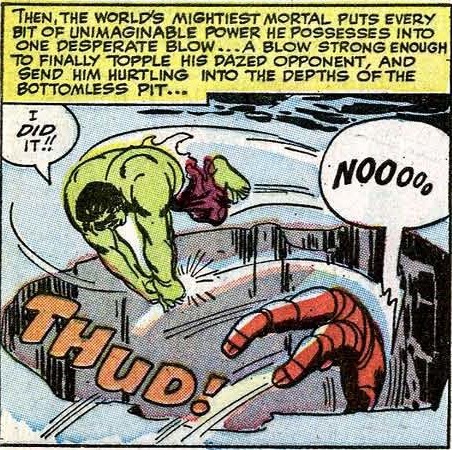
Hulk saves the day by punching a man inside a robot suit into a bottomless pit, then leaping into the air to get hit by a missile said man inside a robot suit launched toward the nearest army base.
He also saves the life of Betty and newly-introduced love triangle angle #3 Major Glen Talbot, who looks somewhat like the General Talbot in the Agents of SHIELD tv show.
I don’t think this guy destroys the Earth in an alternate future while trying to absorb earthquake powers, though.
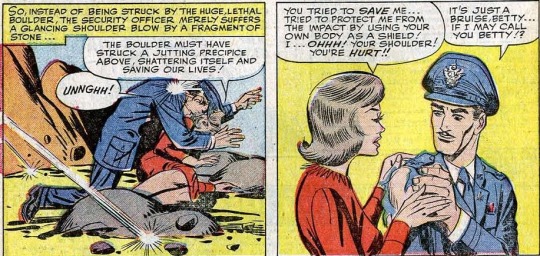
He does try to use his body as a shield to protect Betty...from a boulder.
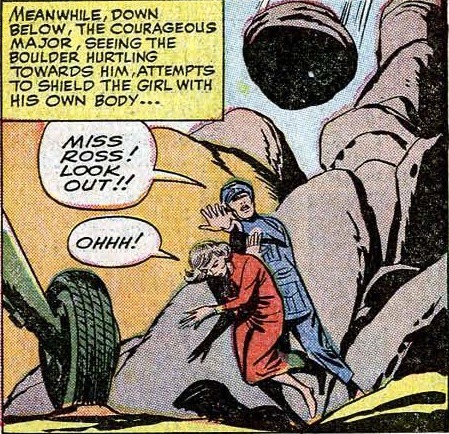
You can’t really tell what the actual size of that boulder is (Is is big and close or really really big and far away?) but let’s say it’s about 4 feet across (1.22 m). I’m not an expert of the New Mexican rock species, but we’ll say whatever this boulder is made of has an average density of 2.5 times that of water, which is typical for many rocks.
It’s been falling over several meters - thrown by the baddie standing on a cliff above them. If I knew anything about helicopters and could be bothered to work out the scale, I could estimate the height more accurately. Instead I’m just going to say it’s 30 meters (98 ft).
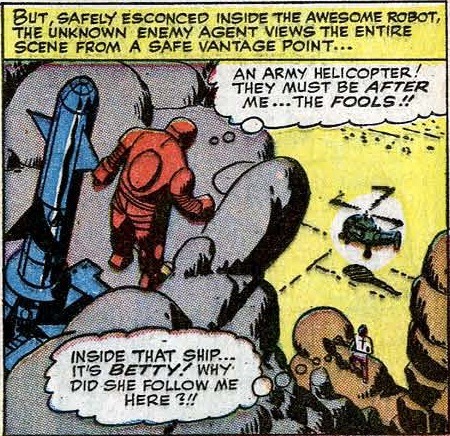
The boulder mass comes out to be 2.37 metric tons, or 5,230 pounds. This is equivalent to a very large hippopotamus. (Feel free to pretend our baddie is dropping a hippopotamus onto them. I am now.) And assuming it had no initial downward velocity, it would smash into them at a speed of 24.5 m/s (55 mph). (Hippopotamuses cannot run this fast, but they can hit about 20 mph...)

If the collision with Talbot’s body lasted half a second, the boulder would impart a force of ~116 kN, which is equivalent to 26,000 pounds of force (and twice the force a T-rex can supposedly bite you...hippos are known for their crushing jaws but they’re not even #1 of the extant species on the planet).
By Gusjer - Hippo at dawn. Chobe National Park, CC BY 2.0, https://commons.wikimedia.org/w/index.php?curid=22523580
0 notes
Text
In the Marvel Universe, there’s a character named Beta Ray Bill.
He wasn’t created until the 1980s, so he’s not in today’s post.
Beta rays, however, are:
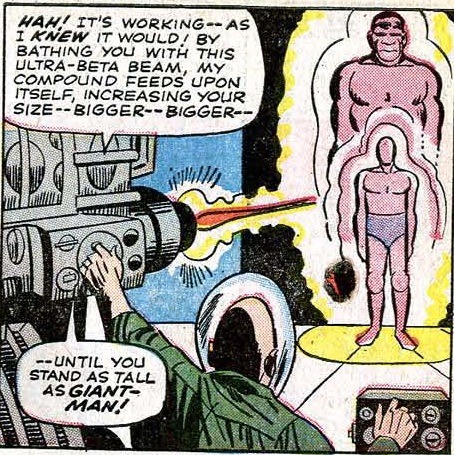
Remember Egghead? Probably not. He’s built himself an android out of a shop mannequin and some magic clay. In a way, it reminds me of the Doctor Who reboot pilot, except he isn’t a sentient glop of plastic.
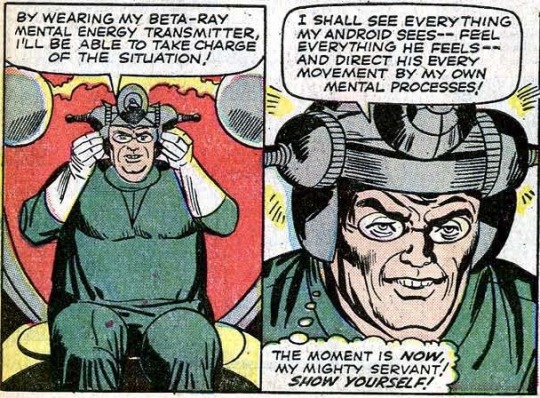
Beta rays are real things - specifically, beams of beta particles. But as you very well suspect, they don’t embiggen golems and don’t let you remote control said golem with your brain.
Beta particles are literally just electrons. Or their antimatter counterpart positrons. But given that as soon as a positron find an electron they explode one another into pure light, we’re probably not talking about them, here.
Technically all electrons are identical to one another (barring quantum spin, but that’s not important here), but we only really refer to them as beta particles when they’re produced during radioactive decay.
Specially, beta (i.e. β−) decay. It’s when a neutron in an unstable atomic nucleus splits apart into a proton, an electron, and an antielectron neutrino. Why it has to turn into these three particles specifically is a consequence of conservation. One is charge conservation: neutrons are neutrally charged, so the net charge of the particles it turns into must equal zero. A proton has a +1 charge, an electron has a -1 charge, and the neutrino has no charge.
But if the proton and electron already cancel each other’s charge, why the neutrino? Well, it’s because neutrons aren’t actually one big particle. They’re actually made of three: two ‘down’ quarks and one ‘up’ quark. When the neutron becomes a proton, it’s actually only changing one of its down quarks into an up quark.
That process is mediated by the Weak Nuclear Force (one of the four fundamental forces in the universe), and requires the emission of one of the WNF’s three boson particles: the positive W boson, the negative W boson, and the neutral Z boson.
Turning a down quark into an up quark produces a negative W boson, which never sticks around for long -- it has to decay into something ‘real’, which almost always ends up being an electron and the anti-electron neutrino*, again conserving charge because it starts as a -1 and splits into a -1 and a 0.
Here’s the second kind of conservation we require: Electrons and neutrinos are in the same family of subatomic particles called leptons. In particle physics, the number of leptons in a system has to be conserved, too. So with the production of a lepton (the electron) you need an antilepton to be made as well.
Physicists have fancy diagrams that chart the whole interchange over time:

But I have long strayed from the point I set out to make.
Let’s change topics.
Egghead’s “android” can manipulate the gravitational constant, making it weigh more or less on command. Maybe. That’s what I want it to be, because I am a nerd and don’t need a rip-off of the Martian Manhunter’s density shifting.
While he says he’s manipulating its weight (i.e. not its density), and we later see it float (see below), it also hurts more/less when you punch it.

Punching a rock (or The Rock) doesn’t hurt because it’s heavy. It hurts because it’s hard. It hurts punching a boulder more than a pebble because it’s harder to make the boulder move, so we’re dealing with collision physics, and conservations of momentum and energy and all that jazz.
Adding/subtracting mass to an object to change its weight, of course, violates a law I covered like 4 years ago. Conservation of mass.
In my mind, I’d much rather prefer a fictional character be able to manipulate the laws of physics than violate the laws of physics...
But that’s just me.
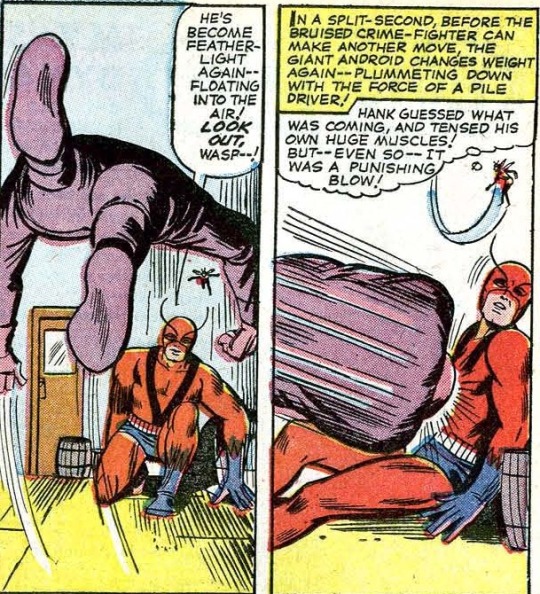
* Technically a W boson can decay into any lepton/antilepton pair (as long as one has a charge and the other doesn’t), or even a quark/antiquark pair if the quarks are opposite types e.g. up quark and anti-down quark, but in the case of radioactive decay the electron/antielectron neutrino pair is far more probable.
Tales to Astonish #61 -- Stan Lee, Steve Ditko, George Bell
2 notes
·
View notes
Text
I’m not touching you!
Behold, Unus: a mutant that is just a slightly exaggerated version of every object in the known universe.

Okay, extremely exaggerated
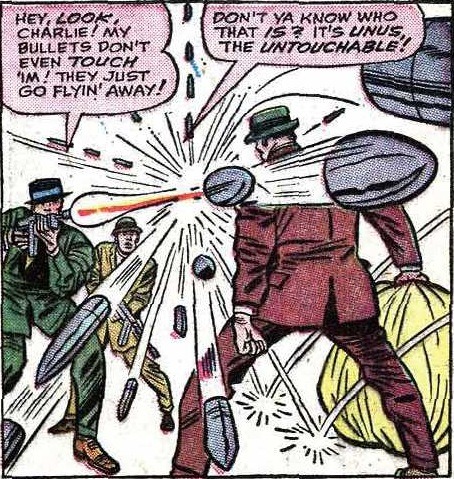
That’s because, if you boil things down to ultimate technicalities, you can’t be touched by anyone else, either.
Although I suppose it depends on your definition of “touching”. I’m using the one that requires direct physical contact between matter bits. Which never actually happens.
You can never touch anything because the subatomic particles (specifically, the electrons) in all your atoms can’t ever actually come into direct contact with other electrons. On one hand, it’s because like-charged particles electrically repel one another. But on the other, quantum mechanics shenanigans cause electrons - while buzzing around in their atomic orbitals - to exert a pressure against one another that keeps them from getting too close.
You can try as hard as you want to push two atoms together, but physics ain’t gonna let you.
The only real-world situations when that happens is when star cores collapse. Stars like our Sun, which aren’t massive enough to go supernova, will shed their outer gas/plasma envelope and the core gravitationally pulls itself together. The only thing that ultimately stops that collapse is the electrons exerting a counter pressure. And you get a white dwarf.
(Stars that are more massive, meanwhile, will have their core remnant not be made of whole atoms, but neutrons. Neutrons have their own “degeneracy pressure”, and can pack way more closely than whole atoms can, so neutron stars can be a good 1000 times denser than white dwarfs - the densest matter in the universe, save black holes. But even then, they’re technically not touching one another.)
But before I go further off on a space tangent, there is one error that this X-Men issue makes...at least if we commit to this line of physics to discuss Unus’s powers. Mr. Untouchable can also not be touched by light.
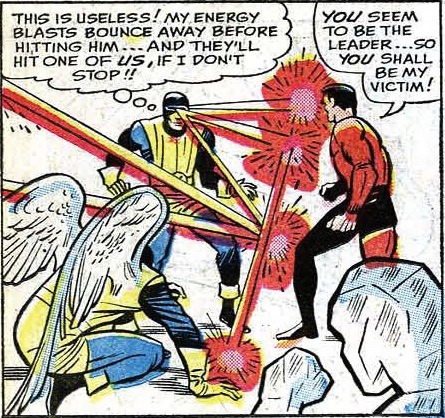
This would require a separate superpower, one that involves electromagnetic manipulation. Indeed, such a power would also explain why nothing else touches him (Again, ‘cause everything’s got electrons).
Including - after Beast shoots him with a power-booster ray gun - cake.
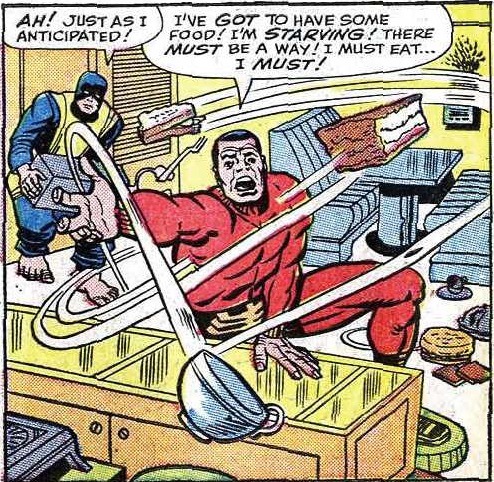
102 notes
·
View notes
Text
When I was 12, I read 20,000 Leagues Under the Sea. I found it nothing to write home about, instead much preferring the quasi-sequel The Mysterious Island. It would be some time later when I actually calculated how long 20,000 leagues actually is, believing it referred to the depth at which the Nautilus journeyed (not the length of the journey).
Traveling a league by land is now accepted to be equal to 3 miles. But traveling a league by sea is equivalent to 3 nautical miles, which is ~3.45 miles (5.5 km). As I understand it, sea leagues/nautical miles are longer because of the Earth’s curvature. And back before airplanes were a thing boats were the only method of transportation that regularly traveled distances so great you had to take the Earth’s curvature into account?
I don’t know. I’m not a historian. I’m a scientist; we use a unit of distance originally defined by how far away the equator is from the North Pole. Most human units are arbitrary because they were set up before we knew anything about science.
But I digress.
20,000 (nautical) leagues is 111,120 km. Roughly the diameter of Saturn, and just longer than the Earth’s circumference around its Equator. (It’s also equal to 23,016 land leagues).
So when you see the following narration, you will now appreciate how its author probably made the mistake 6th grade me did:
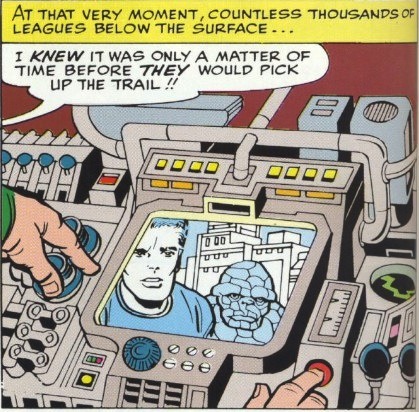
(In non-nautical leagues, the average distance from Earth’s surface to the center of its inner core is 1320, which is a far smaller number than “countless thousands”...)
This booboo also comes in a comic where Mole Man is stealing singular blocks of Manhattan at a time and levitating them down to his lair, and missiles that turn into oxygen-stealing spores, so it’s not actually important in the grand scheme of things...
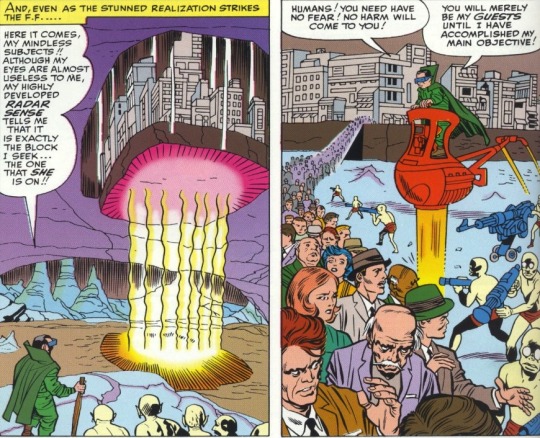
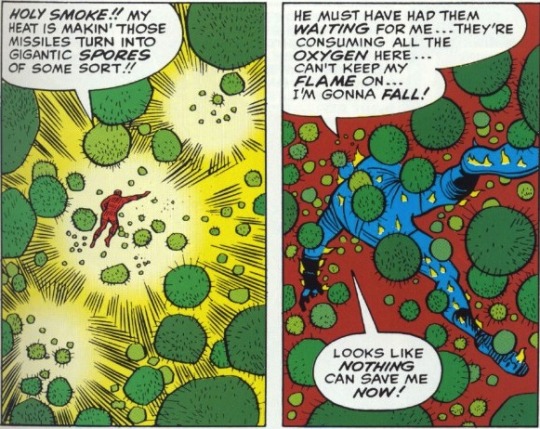
Fantastic 4 #31
1 note
·
View note
Text
Behold Baron Zemo, fashion designer:
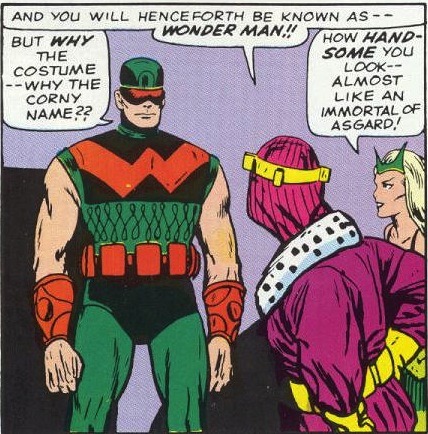
The man wearing Christmas colors is Simon Williams, a white collar criminal seeking “revenge” against Tony Stark (Tony invented tech that made Williams’ obsolete, making him go broke). He agrees to head down to Zemo’s Amazon lair and get bombarded by a bunch of rays to get superpowers.
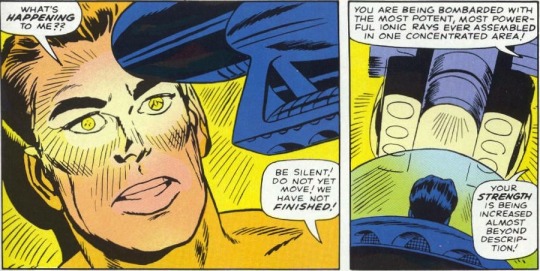
“The most potent, most powerful ionic rays ever assembled” give Williams super strength, super(ish) speed, and indestructibility. They also make him slightly bigger, and the former Nazi rocket scientist gives him a utility belt that lets him fly.
Which, you might think, would allow him to easily dispatch Zemo - if not The Enchantress or her bodyguard - but Zemo makes use of a very real science fact to maintain the upper hand.
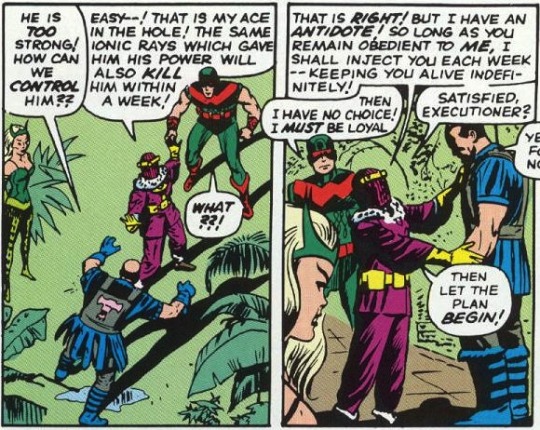
The term “ionizing radiation” refers to any high-speed particles (so, either light like x-rays/gamma rays or massive particles like protons or alpha rays) that are moving so fast they have enough energy that - if they were to smash into an atom, they’d impart so much every to one of that atoms’ electrons that it would fly off.
That atom becomes “ionized, and positively charged because it’s just lost a negatively-charged particle.
When the atoms in living tissue get ionized, that’s damage. Parts of cells no longer can do their job, and - especially if the DNA took the hit - the cell will recognize this and commit suicide (i.e. “apoptosis”). This is, in fact, what a sunburn comes from.
So Williams being exposed to a bunch of ionizing radiation could be as bad as lying on a tanning bed, but seeing as these rays gave him superpowers it makes sense they’re more powerful and therefore more damaging.
In other words, Wonder Man dying because of the source of his superpowers is what should have happened to Bruce Banner. The only thing that isn’t realistic (you know, besides the powers) is that he doesn’t suffer any symptoms of radiation poisoning before his untimely demise.
Sorry I spoiled that for you.
_______________________________________________________________________
But if that’s so accurate, where’s the Bad Background Science in this issue?
It’s here:
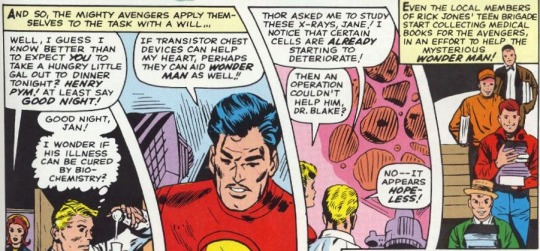
Wonder Man pretends to want to join the Avengers and Steve is super suspicious. Luckily (for the baddies), Enchantress performs some mind mumbojumbo spell that convinces him Williams is dying of a rare disease. And, I mean, that’s not wrong...
Anyway, because the Avengers are the good guys and populated with a large number of STEM dudes, they actually try their darnedest to save his life.
Including looking at an X-ray that somehow can see cells. You know - x-rays - the stuff that can see straight through your tissues do doctors use it to see your bones?
Okay, I’m slightly exaggerating. You can use lower-energy x-rays to observe tissue. That’s how mammograms work. But still, that’s not for looking at individual cells. It’s for catching tumors. X-ray microscopes do exist, but actually damage the specimen you’re looking at. So, probably not the best way to study cells that are already suffering from ionizing radiation.
_______________________________________________________________________
Bonus: here’s Iron Man being defeated by a giant magnet.
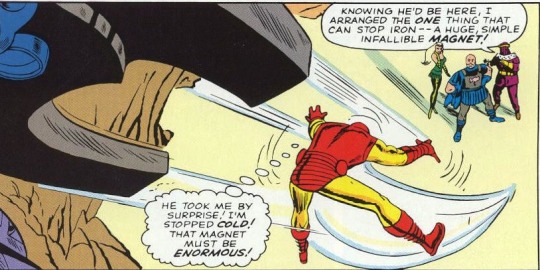
0 notes
Text
Science of “The Seven”
I watched Amazon’s The Boys this week. So instead of the usual 60′s Marvel fare, here’s some tangential science relating to the superpowers featured in the show:
1. Homelander can’t see through zinc.
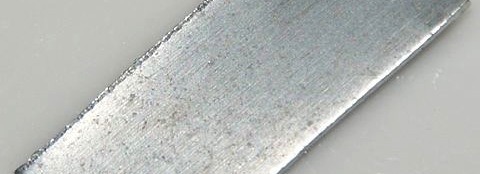
This is obviously a play on Superman not being able to see through lead, but the switch brings up some problems with the physics involved. X-rays - light with wavelengths ranging between 0.01 and 10 nm* - can’t travel through a lump of lead because lead is super dense. It’s nearly the heaviest non-radioactive element, with (usually) 208 protons+neutrons and 82 electrons. And its atoms pack very closely together.**
Combining that density with the fact that lead atoms are also very good at attenuating x-ray light (meaning the amount of x-ray photons that can penetrate a certain thickness of lead drops exponentially as that thickness increases), it makes sense that Superman’s x-ray vision’s weakness is lead.
But zinc is a smaller atom (usually 64 protons+neutrons and 30 electrons) and its atoms don’t pack as tightly; it’s about 1.5 times less dense than lead. It’s X-ray attenuation is generally lower, but not too different, from lead (compare this graph vs this one). Together, this makes it easier for x-rays to penetrate zinc than lead.
So why can’t Homelander see through zinc, but (supposedly) see through lead? It could be that the x-rays he emits correspond to a wavelength that zinc absorbs more than lead does. Annoyingly, the absorption spectra I can find all seem to be dealing with zinc compounds (e.g. ZnO, ZnS) instead of pure zinc metal. So I can’t tell you exactly what wavelength that would need to be.
Sorry.***
2. The Deep has torso gills

Fish are ectotherms, meaning their body temperature is regulated by their environment. Mammals - including cetaceans (i.e. whales, porpoises, and dolphins) - are endotherms. We generate our own body heat. Kevin presumably does, too.
This means that a man needs more oxygen than a man-sized fish does. About 15 times the oxygen, in fact. It’s the gills’ job to extract oxygen from water and pump it into the fish’s bloodstream; bigger fish have bigger gills, but a 75-kg man needs gills 15 times the size of a 75-kg fish’s. Not necessarily in length, but in collection area. And that’s assuming you’re not doing any physical activity that ups your oxygen requirements.
But on top of that, oxygen is far less abundant in water than it is in air - about 20 times less for the same volume. If an average human needs a quart**** of oxygen per minute, their gills would need to strain 51 gallons of water every minute to meet that requirement.
Combining these two factors, designer and material scientist-dabbler Jun Kamei is developing a set of artificial gills, and claims the final device will have a surface area of 32 square meters (344 square feet).
The human lung surface area is somewhere around 75 square meter range, so if you’ve got gills that can pack as efficiently as lungs do, you probably could fit them into your abdomen. Maybe not Chase Crawford’s abdomen, but a stockier human’s abdomen.
The real problem here is that Kevin’s doing himself no favors by covering the gills up while he’s underwater. Water rushing through the gills is the whole point, and you’ve just made it 1000% harder.
3. A-Train (and Popclaw) booms and bu(r)sts
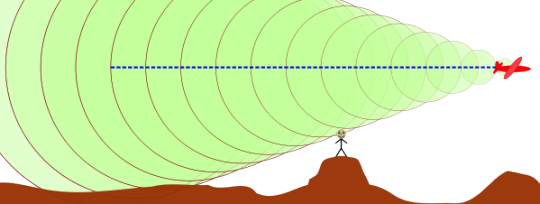
According to the race announcer that one episode, A-Train can reach speeds over 1000 miles per hour. Assuming that’s true and not a horrible exaggeration, as soon as he passes the speed of sound (767 mph at sea level), A-Train would create sonic booms. Not a single boom. Constant booms for as long as he’s going fast enough. You (as a single individual) only hear one, but that’s only because you’re not moving.
We never see him do this, so we must conclude he’s not a complete idiot and only goes this fast when he’s far away from people and architecture. (If I read the screen right, he only clocks in at 371 in his race.)

As for the secret girlfriend he murdered, there are several species of amphibians that can stick their own bones out through their skin to use as weapons. For example, species of frog within the genus Astylosternus, and Trichobatrachus robustus (aka the hairy frog). The Spanish ribbed newt can push its ribs out through its torso; when threatened, its skin also secrets poison, turning its bones into poisonous barbs.*****
4. Translucent isn’t see-through. He’s see-around.
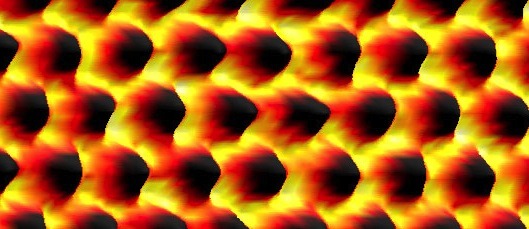
As the man explains to Jimmy the late night host (No, not that Jimmy the late night host...the other Jimmy the late night host), his skin can convert at will to a “carbon metamaterial” that bends light around it.
We don’t know if there are other elements involved besides carbon, but if there aren’t, the real-world comparison is graphene -- an atom-thick layer of carbon atoms bonded to each other forming a honeycomb pattern.
Given its thickness, it’s translucent itself. [Side note: yes, “translucent” doesn’t mean invisible. However, some dictionaries (e.g. Merriam Webster and the OED) include alternative definitions identical to "transparent"...which goes against everything I ever learned. But either way, he actually is translucent when he isn’t “translucent”. Because human skin is translucent, assuming there isn’t too much melanin in it.]
A 2D sheet of graphene has a breaking strength of 42 Pa (0.0061 psi). That number seems super small, but it's actually reflecting the strongest material we know of. You'd need 4,300 pounds balanced on a pencil (pointy end on the graphene) to break through that atom-thick sheet.
Alternatively, if I did my back-of-the-envelope math right, you’d need a 50 gram .50-cal bullet traveling at ~770,000 mph (and coming to a stop in ~1 millisecond). Now, the human epidermis averages ~1mm thick. That's 3 million layers of graphene.
However, if you manage to put a crack into your graphene, it becomes brittle on par with a ceramic.`*
As for being able to electrocute Translucent because carbon is “highly conductive”, graphene is indeed so; however, other carbon compounds aren't (e.g. diamonds). It all depends on the positioning of electrons within the solid (moving electrons = flowing charge). Since we don’t know what Translucent’s metamaterial is, we’ll have to take the show at its word.
Though here’s some bonus info: metamaterials are all synthetic. Which would mean that Translucent had this skin installed somehow. Or, it’s a very subtle dig at Compound V being used to create superheroes that only I caught.
The one thing that the season left bugging me about Translucent was his eyeballs. Somehow those are see-through.
5. Starlight pushes it real good

Our newest member of the Seven can use concentrated light to knock baddies off their feet, as well as throw them several meters back. This is an exaggerated form of reality. Light can actually push stuff.
Photons do exert a teeny tiny amount of pressure on whatever they hit. It’s called radiation pressure. The amount is sufficient for something like a solar sail (The above image is LightSail 2), but not wiping the floor with a criminal.
According to (more) envelope math, Starlight would need to emit ~30 PetaWatts to deliver a good boxer-level punch to a baddie standing ~2 meters away. That's the equivalent amount of energy released by 7.2 million tons of TNT exploding, in 1 second.
Also, given the color of the light she emits, she’s probably emitting a spectrum identical to our Sun, meaning she’s emitting a ton of light that normally gets blocked by our atmosphere, including x-rays and ultraviolet radiation.
She’s definitely given someone a melanoma at some point during her life. Or at least a very bad sunburn.
Bonus: Ice Princess shatters wangs

Final back-of-the-envelope math, calculating how fast that guy's (presumably erect) penis would freeze being enveloped by an ice vagina at -346 °F (-210 °C). A combination of calculating the heat lost per second via conduction, and the amount of energy lost as body-temp water cools and converts to ice.
Came out to 0.1 seconds.
Faster than I expected...
_______________________________________________________________________
* Visible light is ~400-700 nm
** There are several (nonradioactive) metals more dense than lead, but more rare/expensive, like gold and iridium.
*** Also, brass can be up to 45% zinc. Does that mean Homelander can only sort of see through brass?
**** Get out of here with your imperial units, self...
***** Fun fact: it can regenerate lost limbs, heart tissue, brain cells, and its spinal cord
`* Butt cracks don’t count.
_______________________________________________________________________
Image credits:
Zinc - CC BY 3.0
gills By Chris 73, CC BY-SA 3.0
frog claws from Barej et al 2010
sonic boom By I, Melamed katz, CC BY-SA 3.0
graphene By U.S. Army Materiel Command, CC BY 2.0
lightsail 2 By Josh Spradling / The Planetary Society CC BY-SA 3.0
ice by Ian Mackenzie CC BY 2.0
10 notes
·
View notes
Text
Yes, stick a tree on your submarine. Why sneak up to the city without anything sticking up above the water?
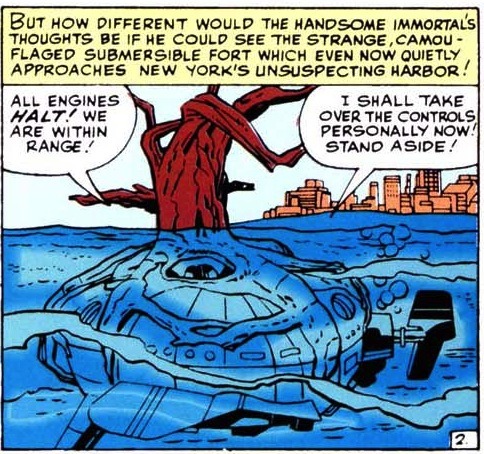
Apparently there’s a periscope hiding up there. But Thor wouldn’t have found Magneto’s secret fort if he hadn’t noticed a giant tree sticking out of the water.
...But I digress.
Let us start with a quick lesson on units:
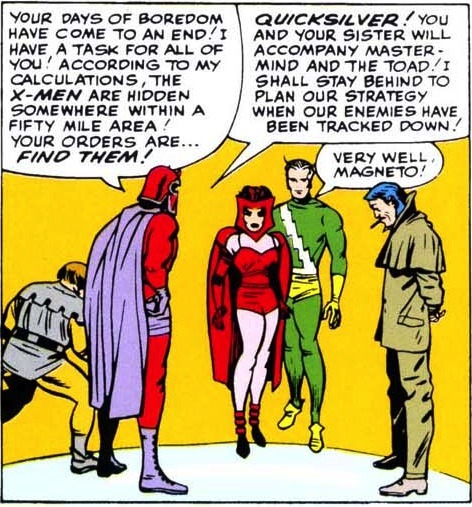
50 miles is a measure of length (or distance). 50 square miles is a unit of area - it’s equivalent to, for example, a circle with a radius of about 4 miles. So Maggie’s meaning to say the X-Men are within 4 miles of their undersea treehouse.
A circle with a 50 mile radius has an area of 7854 square miles, which is basically the size of Wales, and 26.5 times the area of New York City.
I for one, would not want to search the entirety of Wales for some hiding superheroes. But I am not a dumb Magneto minion.
I am also not the Norse god of thunder, upon whom Magneto demonstrates the principle of diamagnetic repulsion:
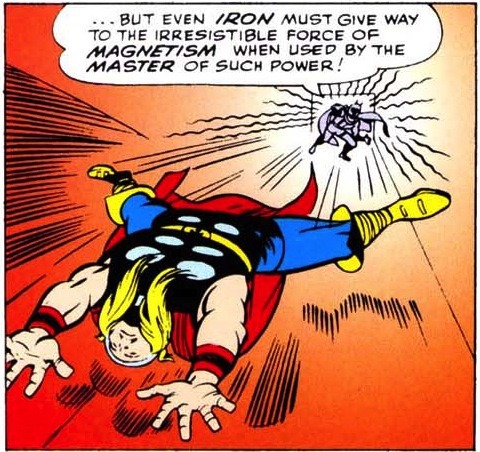
Diamagnetism has popped up with Magneto before, but to summarize, it’s the type of magnetism every single substance has. That’s because moving charge creates magnetic fields, and electrons are bundles of charge constantly buzzing around inside the atoms that make up stuff. That includes ‘magnetic’ lumps of iron, but also water, and wood, and human bodies.
The reason why these compounds don’t seem to be magnetic is because, all together, the electrons’ magnetic fields cancel each other out because they’re all randomly pointing every which way. However, in the presence of an external magnetic field - like one created by a supervillain - they can be forced to cooperate.
And as Thor demonstrates above, substances that only display diamagnetism are repulsed by that external magnetic field.
However, his body cannot be attracted by an external magnetic field, as Magneto attempts to do later in the comic.

The easy argument around this is that Magneto is attracting not Thor himself, but some metal in his costume. So we’ll leave it at that.
Bonus: Magneto calls his nuke a proton bomb.
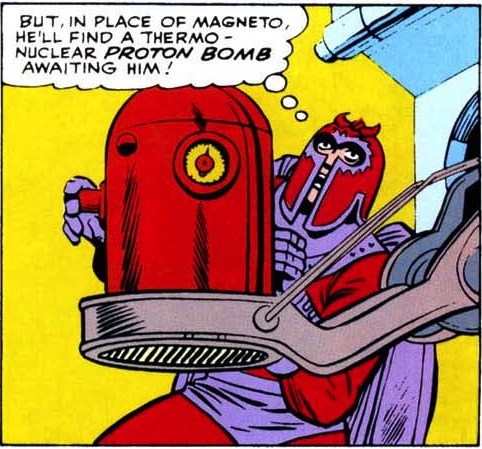
Protons are Hydrogen nuclei. It’s just an H-bomb.
Well, I say ‘just’. It’s still a nuke. A nuke that sinks to the bottom of the Hudson at the end of the issue and Thor thinks it’s harmless despite being a medical doctor and therefore no expertise in particle or nuclear physics.
_______________________________________________________________________
Journey Into Mystery #109
1 note
·
View note
Text
My hat is like a shark’s fin
How not to draw sharks, exhibit A:
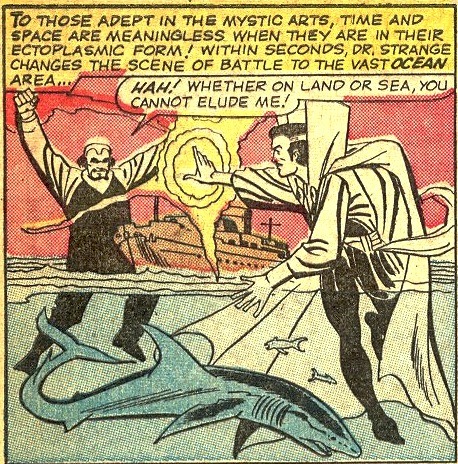
I mean for one, this poor guy (or gal...I do not know how to sex* a shark) looks like he’s having some kind of bad day. But for two - and in fact it may be related to the first - that back end looks wrong.
I’m no sharkologist (is there something more specific than a marine biologist? Do ichthyologists study cartilaginous fish?), but I can identify some types of fins. Sharks have many:
pectoral - located on each side, act like airplane wings (allows shark to steer up/down or side to side)
dorsal - on the back (includes both the main one that sticks out of the water to scare people in movies, as well as smaller ones further down the spine)**, provides stability to movement
pelvic - located on the underside of sharks, for changing direction when swimming
anal - (optional)*** for stability and balance
caudal - the one at the end
The caudal fin often tells you how fast and maneuverable a shark is, based on its shape and how symmetric the top and bottom half are to one another. Fast open-water sharks like Mako and Great Whites have very symmetric tails, but your average shark will have the top part longer than the bottom.
Below are examples of Great White, Whale Shark (the largest fish species alive), blacktip reef shark, and thresher shark. There are nearly 500 extant species - some of which don’t have the ‘typical’ shark shape (see: angel sharks) - so Odin knows I’m not going to show you all of them.
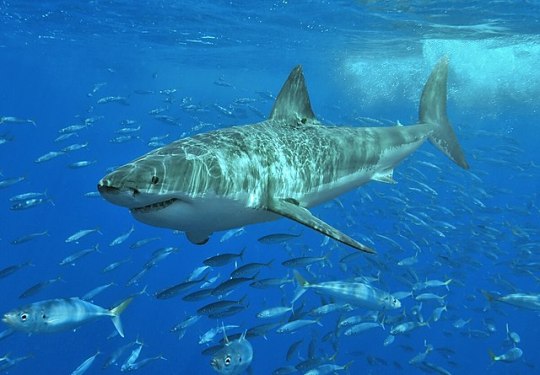
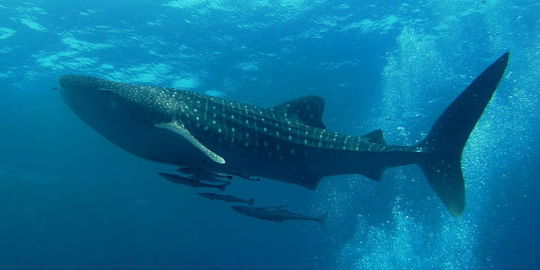


But there is one thing all these different caudal fins have in common. They’re oriented vertically, not horizontally, as is suggested in the comic panel.
That’s what marine mammals rock.
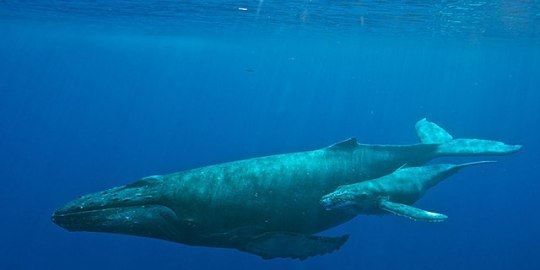

The reason for this is evolution. Cetaceans actually returned to the water millions of years ago, after developing land-based, 4-limbed skeletal structures. That included a gait wherein the spine moved up and down during movement, not side to side. That movement was preserved over the years as they lost their back legs, translating into perpendicular (relative to fish) tail fins - or, rather, “flukes”.
So our poor shark, whose day has been sadly interrupted by two dueling wizard spirits, has been suffering from a tail that has been completely twisted the wrong way ‘round for who knows how long.
Or the artists just don’t know how to draw sharks. Equally as likely.
And remember, folks. Sharks are friends. Not food.
_______________________________________________________________________
* But I do know chicken sexing - i.e. determining whether a chick is male or female - is a very difficult job.
** the taxonomic order Hexanchiformes - the most primitive order of shark - has only one dorsal fin
*** orders Squaliformes, Squatiniformes, and Pristiophoriformes don’t have an anal fin
Strange Tales #125
Image credits:
great white By Terry Goss, CC BY 2.5
whale shark By Abe Khao Lak - Own work, CC BY-SA 4.0
thresher shark By Thomas Alexander - Own work, CC BY-SA 4.0
black-tip reef Public Domain,
humpback By National Marine Sanctuaries - Whales, CC BY 2.0
beluga whale By Stan Shebs, CC BY-SA 3.0
4 notes
·
View notes
Text
Oh look, it’s another superheroes fighting each other on the cover to get people to buy our comic gambit:
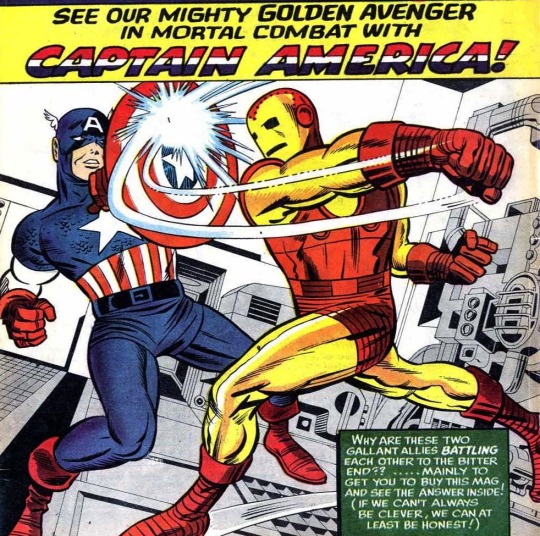
Spoiler alert, Tony thinks Cap is the Chameleon. It’s like Avengers: Endgame with the characters all mixed up.
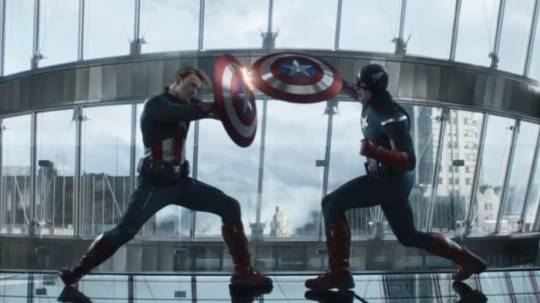
But anyway, everything gets settled when Giant Man comes to save the day; the issue ends with Kraven the Hunter back in America and Iron Man quoting a president who used to show dudes his penis without their consent.
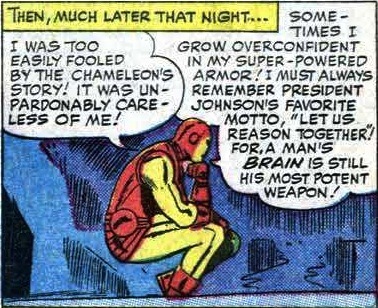
With that fun fact aside, let us move on to our brief moment of science:
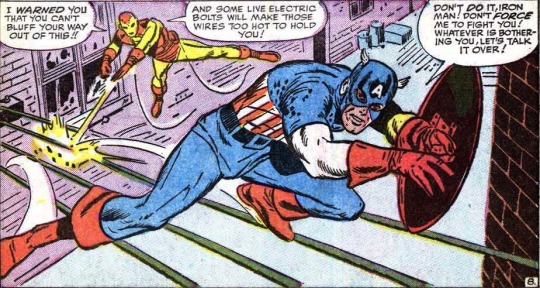
You learn a bit of electric circuit physics in high school (or at least you do if you pay attention in physics class), including the relationship between several units of measure and physical concepts.
They include
Current (symbol = I, because France): the amount of electric charge passing by a given point, assuming an infinitely thin wire, per second
Voltage (symbol = V): the amount of oomph pushing the electrons through the wire
Resistance (symbol = R): basically how much the wire opposes the flow of charge. Think friction for electricity, but it’s not a force. Generally described as V / R, but that’s in ideal scenarios. In reality, it can vary for a single material based on e.g. temperature.
Power (symbol = P): V times I, the amount of energy carried per second
There’s a classic cartoon that demonstrates the relationship between V, I, and R, but here’s a crappy one that gets the idea across that is also creative commons:

So beautiful.
As electrons move through the wire, they bump into the atoms of said wire and impart some of their kinetic energy. That energy gets absorbed by the atoms, and some (or rather, most, since it’s a metal), gets converted into thermal energy. Heat.
The faster your electrons are moving, the more energy they have available to impart. Hotter wire.
Get hot enough and you actually start emitting light that’s visible to the human eye. (Prior to that it’s still there, but infrared.*)

The average human being (which Steve Rogers most certainly is not) starts experiencing pain due to temperature at around 45 degrees Celsius - at least for water. And the max tolerable temperature is around 60ish Celsius (140 °F).
Metal has a massively different ability to conduct heat than water does, which means touching a metal bar that’s 45 °C and submerging your hand in 45 °C water will feel different. The metal will feel hotter because it’s better at pumping its thermal energy into you than the water is.**
So exactly how much Tony needs to heat the power lines to make them too hot for Cap to handle (or, might I suggest, melt the rubber in his shoes so he gets stuck to the wire, take a tumble onto the other wires, and get electrocuted) isn’t something I’m going to even think of calculate, but can at least present possible ways he can do it.
___
Voltage in your standard house - or in the big wires carrying electricity from the power station to your house - is set by the power company; the amount of current flowing through a system is, therefore, normally determined by the innate resistance of the stuff the electrons are flowing through, be it steel or human flesh.
The wires here aren’t changing their makeup, and Tony’s not near a transformer to increase the voltage, so what is he to do?
He could generate a positively-charged electric field to attract the electrons, or a negatively-charged one to repel them. That would speed them up, increasing the current. Though to do that, he’d need to be parallel to the wires -- not off to the side.
Or he could pump a load more electrons into the wire traveling at the same speed as the ones already in there. That’d increase the total charge passing through a wire segment per second, and therefore increase the current, too.
His “live electric bolts” are likely supposed to suggest something of the latter, but there’s quite the chance he’d end up electrocuting Cap (whom Tony has mistaken for a dude who has no superpowers), rather than just heat the wire up however many meters down the line.
So poor thinking on Tony’s part. He should have just used his fancy rocket boots to speed up and then hoist his target thousands of feet into the air. Or, I don’t know, just punch him off the wires. Why does Tony think the Chameleon has the same physical skills as Captain America?
Use that potent weapon of yours, Tony.
_______________________________________________________________________
* Incandescent light bulbs actually emit 95% of their light as invisible to the human eyeball. Meaning it works way better as a heat lamp than as what we use them for.
** Conversely, metal at 0 °C will feel colder than water at 0 °C (right before it freezes).
Tales of Suspense #58 - Writer: Stan Lee, Art: Don Heck, Ink: Dick Ayers
Ohm’s Law diagram By Christinelmiller, CC BY-SA 4.0
0 notes
Text
You wouldn’t like me when I’m excited
The Hulk is back - not in his own comic, but at least in his own storylines -- in Tales to Astonish.
And it’s now that Banner learns he turns into the Hulk when he gets too stressed. Not necessarily angry, though.

But weirdly, getting too excited also turns the Hulk back into Banner. Makes no sense to me, but I don’t make the rules.
In this story, Banner has constructed a prototype robot suit within which a person is supposed to stand closer to an atomic explosion than would otherwise be permitted for health and safety reasons. But because General Ross ups the deadline and a bad guy sneaks onto the base, Banner gets too excited, turns into the Hulk, and runs away.
Leaving the baddie to hide inside the robot and go to the test site.
And get stuck inside.
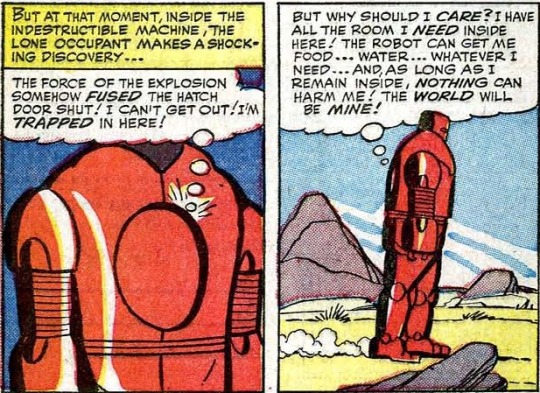
The Hulk fights the robot - which might arguably be the first Hulkbuster - but gets mad when throwing it does nothing.
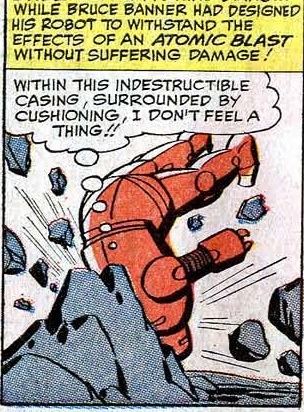
This might be the first time I’ve seen any reference to cushioning actually being a necessary component to protect the squishy human inside a metal shell! Like, it’s probably not enough for a puny person to actually survive sans damage after being tossed into a rock by a giant green rage monster, but I give whomever wrote this thought bubble major props.
It all comes down to a physics principle called impulse, which relates the amount of force you experience and the time over which you experience it to your change in momentum.
Mathematically, it looks like this: FΔt = Δp
Δ stands for “change in”; p stands for momentum. Physics is nonsense, sometimes. p depends on both an object’s mass (m) and its velocity (v). In this case, the baddie in his robot suit’s mass is constant, so his Δp only depends on his Δv.
The cushioning increases the Δt of the impact, which - for any given Δp - decreases the F.
An infinite Δt would drop F to 0, i.e. “not feeling a thing”. Which isn’t realistic, but the above exclamation is a mere exaggeration.
And a reminder that every time Iron Man crash lands his squishy Tony body should very much feel. A lot.
Tales to Astonish #60 - Writer: Stan Lee, Art: Steve Ditko, Ink: Geo. Bell
0 notes